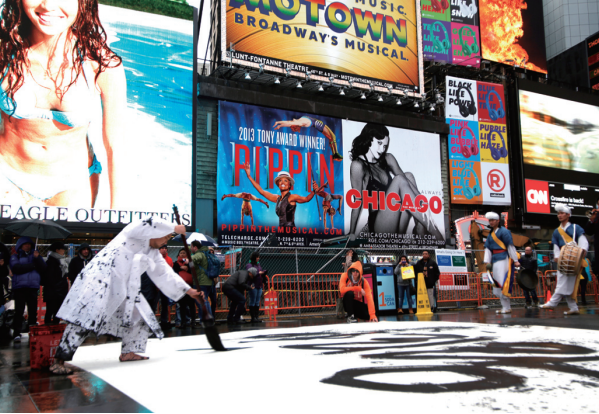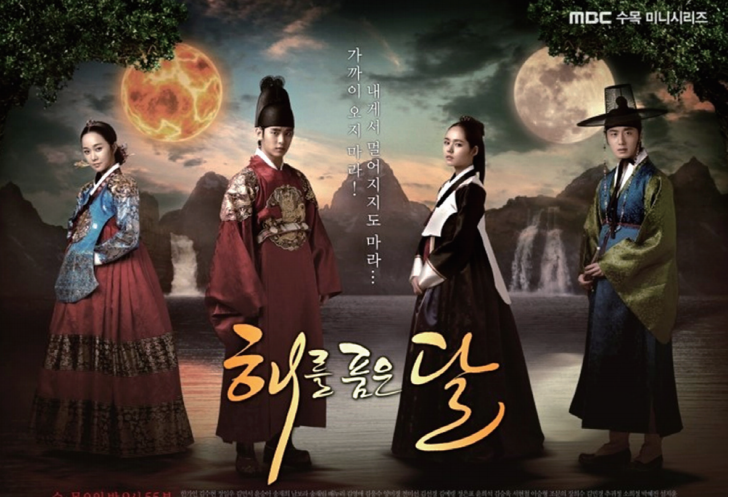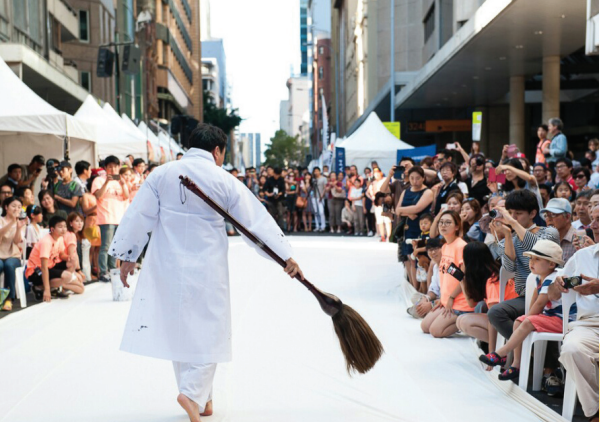Hangeul Day, when Korean people celebrate the invention and their use of Hangeul, is in October. There are many ways of celebrating the day, and lots of people have been trying to spread Hangeul all over the world. In particular, the calligrapher Lee Sang-hyun is one of them, who has been trying his best to promote the artistry of the Korean alphabet to the world. Indeed, some Kingos may be familiar with the fonts used in the title of the Korean drama named Moon Embracing the Sun and the branding for Korean fried chicken company Kyochon Chicken, which he worked on before. Therefore, the Sungkyun Times (SKT), met with Lee Sang-hyun, the Hangeul calligrapher, and listened to some of the stories about his life and works.
An Early Korean Calligrapher Breathing Life into Hangeul
Q1. Please introduce yourself to the Kingos.
My name is Lee Sang-hyun. I am a calligrapher who “emotionalizes” handwriting. I majored in Korean Calligraphy at Wonkwang University (WKU) and continued studying by getting a master’s degree in Korean Calligraphy from the Graduate School of Confucian Studies at SKKU. In 2014, I held a Korean calligraphy performance using the Korean traditional song, Arirang, in Times Square in New York. Also, I am trying my best to spread the culture of calligraphy all over the world.

Q2. You started calligraphy in elementary school and majored in calligraphy at the university. Is there any special reason for starting a career in calligraphy?
Since I was kind of a naughty boy when I was young, my parents advised me to attend a Korean calligraphy academy to improve my concentration. In the beginning, writing with a brush was something I did not want to do, so I scribbled on the white wall. In fact, I was worried about being scolded by the teacher, but unexpectedly, he complimented me. He even requested me to change the color of the white wall to black. After that, I started to go to the academy regularly to grind an ink stick and paint the wall with black ink. It was my first time to hear a compliment from a teacher. Thanks to a few words of praise from the calligraphy teacher, I tried harder and finally won the 1st prize in a national competition with such experiences. I learned that I could get a good result in calligraphy by trying hard, and I decided to pursue a career as a calligrapher, majoring in calligraphy at the university and graduate school.
Q3. What drove you to study Korean calligraphy for such a long time?
My favorite part of Korean calligraphy was the process of handwriting itself. When I ground the ink stick, the fragrance of the ink really attracted me to calligraphy. Also, Hwaseonji (Korean traditional paper) soaking up the ink when I wrote a letter with a brush on the paper caught my eyes. In addition, I love calligraphy because I can read a lot of good phrases. For instance, when I wrote calligraphic teachings about self-discipline for living a good life, I always kept those lessons in my mind by writing them with my own hands. It was a grateful experience to me whenever I wrote calligraphy.
Q4. Which was the hardest part in the process of creation?
It is common for artists to find reflecting their imagination very hard, and if the figure of the imagination is not expressed well, an artist would commonly be in trouble. Whenever I cannot express my thoughts with my hands well, I experience a slump. Even though it is hard to get out of the slump, putting in continuous effort and training is the only thing which can help me to overcome it. The effort here means undergoing several trials and errors through trying variations of calligraphy, rather than just repeating the same style more than a hundred times. I tried to make some combinations by changing the composition of my work, the size of the calligraphy, the texture of the brush, and the types of Hwaseonji.
Q5. Early Korean calligraphy was usually written in Chinese characters since Chinese calligraphy was introduced to Korea. Despite this fact, why are you mainly using Hangeul in your works?
The reason why I usually use Hangeul in my works is because of communication with the public. To maintain and develop our own traditional culture and art properly, it is important for early Korean calligraphers to communicate with the public. The public was not very interested in Chinese calligraphy in the past, so I thought that Hangeul could be a new breakthrough for the popularization of calligraphy. In fact, I think Hangeul has great strength in calligraphy. Only Hangeul has final consonants, among letters from all over the world and shows diverse heights on each letter, which expresses a dynamic and rhythmical image. While a number of strokes in the alphabet are normally similar, some letters like 뷁 in Hangeul have many strokes.
A Modern Artist Embodying Culture in Calligraphy
Q6. There might have been some people expressing an opposite opinion when you first started modern calligraphy. How did you push ahead with it?
It hurt me to see that many people did not realize the value of calligraphy and even had some prejudice against calligraphy. In particular, I wanted to change young people’s recognition of calligraphy as a preserve of the old generation. Thus, I decided to make calligraphy penetrate into the modern lives of people. Furthermore, I wanted to express the good sides of culture through calligraphy. A basic principle of calligraphy is that the handwriting reveals much about the personality of each person, and I wanted to elevate this spirit into an art form. I always believe that if everyone enjoys calligraphic culture in which people know the importance of living with a healthy state of mind, the world would become a more peaceful place. Therefore, I have been trying to spread Korean modern calligraphy to modern people in the hope that they would accept calligraphy culture more easily.
Q7. What is the difference between traditional and modern calligraphy?
It is more accurate to say that they have a special relationship rather than to say there is a difference between them. The essence of these two styles of calligraphy is the same, but the way of utilizing them is different. Calligraphy has its own property with a deeper introspection because it makes a person take time for self-reflection. Modern calligraphy also has this kind of feature but it can be applied to any object with changes depending on the circumstances. For instance, when I worked on the title of the film Tazza: The High Rollers, I had to create the proper style of handwriting considering the genre of the film not just by writing with my own handwriting style. I needed to create a new handwriting style to represent the contents of the original works. Modern calligraphy, however, seems to be going back to the style of the early Korean calligraphy. It has expanded to a new genre called “Healing Caligraphy,” whose purpose is in a person him or herself. Many people calm themselves by doing healing calligraphy, which is a very positive trend. In short, there is an indefinable relationship between two kinds of calligraphy styles.

Q8. Which is your most memorable work among all of them? Why did you choose that work?
The work of the title in the drama called Moon Embracing the Sun is my most memorable work. In fact, it was such a hard work to finish. The genre of the drama was in between historical drama and modern play, so I had to find a way to express it well by studying the drama. The story was based on a great queen who influenced her husband, who was a sovereign, in a good way. After studying the drama shows by myself, I created the handwriting using the symbol of the drama: the letter of the moon symbolizing a queen holding up the letter of the sun which symbolizes a king. By including the story of the drama into the image of handwriting, I felt that the work of that drama title was worthwhile. Therefore, I would choose this work as the most memorable one.

A Pioneer Moving Toward the Future with the Brush
Q9. What do you try to keep in mind while working on calligraphy?
“Handwriting reveals much about the personality of each person,” the saying I mentioned before, is my faith. I always try to work on something with all my heart, not with hypocrisy. Even though I am already used to creating calligraphy, I usually start my work by getting interested in the object and feeling a connection with a direct or indirect contact. Because the result of the work can reflect the state of my mind, it is very important to maintain an interest in that object.
Q10. What is your dream or ultimate goal in your life?
I think, to some extent, that my first dream of introducing Korean calligraphy and Korean calligraphic culture to the public has already been achieved. Until now, I have tried to make calligraphy familiar to the public by using Hangeul. I hope more people will care deeply about calligraphic culture. Thus, I have the dream of building a school where I can educate both early and modern Korean calligraphy. At this school, students may be able to learn about traditional and modern cultures, so they can spread the charming points of Korean calligraphy to the world.
Q11. Do you have any plans to start a challenge other than in calligraphy?
I really want to travel the world. I am planning to go to several countries that I have never been to before. In particular, Switzerland would be an excellent place to enjoy its nature. I want to make works traveling all over the world. Among many countries, I want to go to the South Pole, where the King Sejong Antarctic Station is located. It would be a great opportunity to make unique works by using Antarctic ice water for ink. Also, I hope I can learn about other special cultures from other countries by communicating with the locals while traveling.

The calligrapher, Lee Sang-hyun, who has a passion for Hangeul, advised that Kingos should also have a great passion in order to achieve their goals. As he grew with brave passion and became a great Hangeul influencer under the unconditional love from his teacher, the SKT hopes that Kingos also meet a life mentor and indulge in their passion to influence others positively.
